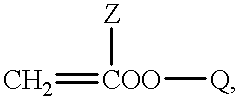Water plasticized high refractive index polymer for ophthalmic applications
- Summary
- Abstract
- Description
- Claims
- Application Information
AI Technical Summary
Benefits of technology
Problems solved by technology
Method used
Image
Examples
example 1
Various copolymers are prepared by mixing the following ingredients under reduced pressure: a first, second and third monomeric component, a crosslinker and a polymerizable UV blocking agent. Vinyl benzotriazole at a total concentration of 0.3% by weight is utilized as the UV blocking agent. To initiate polymerization a free radical initiator 2-2'-azobisisobutyronitrile (AIBN) is employed at concentration of 0.2% by weight. The monomer solution is mixed in a glass flask using a magnetic stir bar for 30 minutes. The solution is then filtered through a 0.2 micron (.mu.) filter and injected into a sheet mold comprising two glass plates held together with spring clips and separated by a plastic gasket. The mold is then placed in a water bath for 10 hours at 60.degree. C., then removed and post cured at 95.degree. C. in oven for 12 hours. A clear, hard polymer sheet is obtained.
Intraocular lenses of various diopters (5, 10, 20, and 34) are cut from the rigid plastic sheet using conventio...
example 2
A hydration study was conducted to assess the change in dimension after complete hydration. Twenty samples of each formulation described in Example 1 were used. Samples consisted of disks 16.5 mm in diameter and 2.0 mm in thickness. The results were averaged for each formulation.
There were no significant dimensional changes after hydration.
PUM
| Property | Measurement | Unit |
|---|---|---|
| Percent by mass | aaaaa | aaaaa |
| Percent by mass | aaaaa | aaaaa |
| Percent by mass | aaaaa | aaaaa |
Abstract
Description
Claims
Application Information
 Login to View More
Login to View More - R&D
- Intellectual Property
- Life Sciences
- Materials
- Tech Scout
- Unparalleled Data Quality
- Higher Quality Content
- 60% Fewer Hallucinations
Browse by: Latest US Patents, China's latest patents, Technical Efficacy Thesaurus, Application Domain, Technology Topic, Popular Technical Reports.
© 2025 PatSnap. All rights reserved.Legal|Privacy policy|Modern Slavery Act Transparency Statement|Sitemap|About US| Contact US: help@patsnap.com



